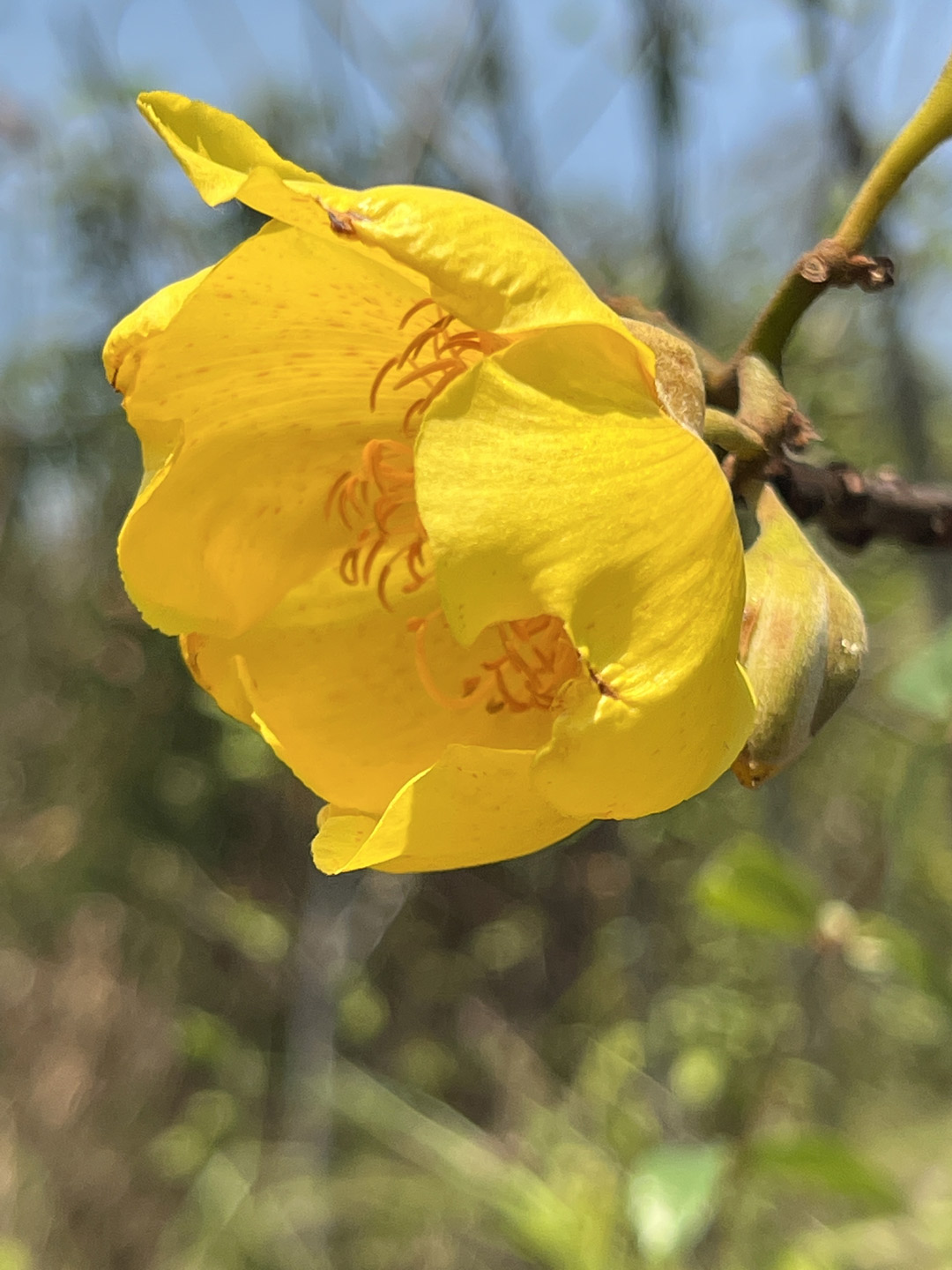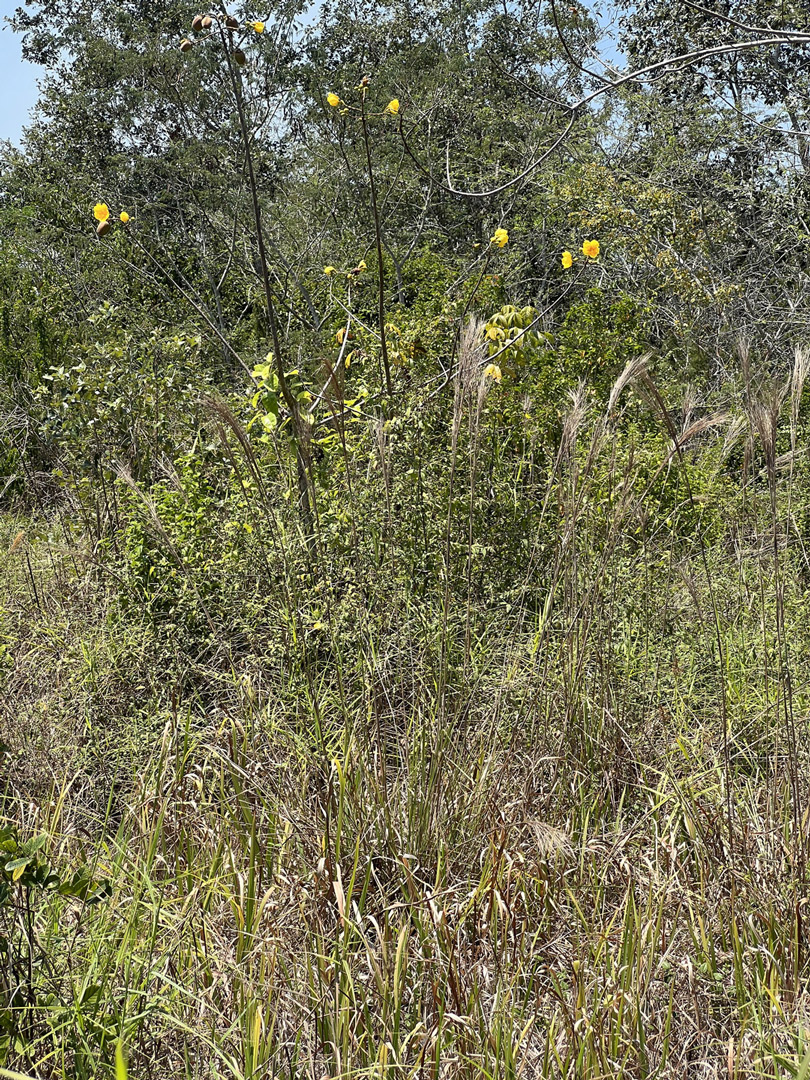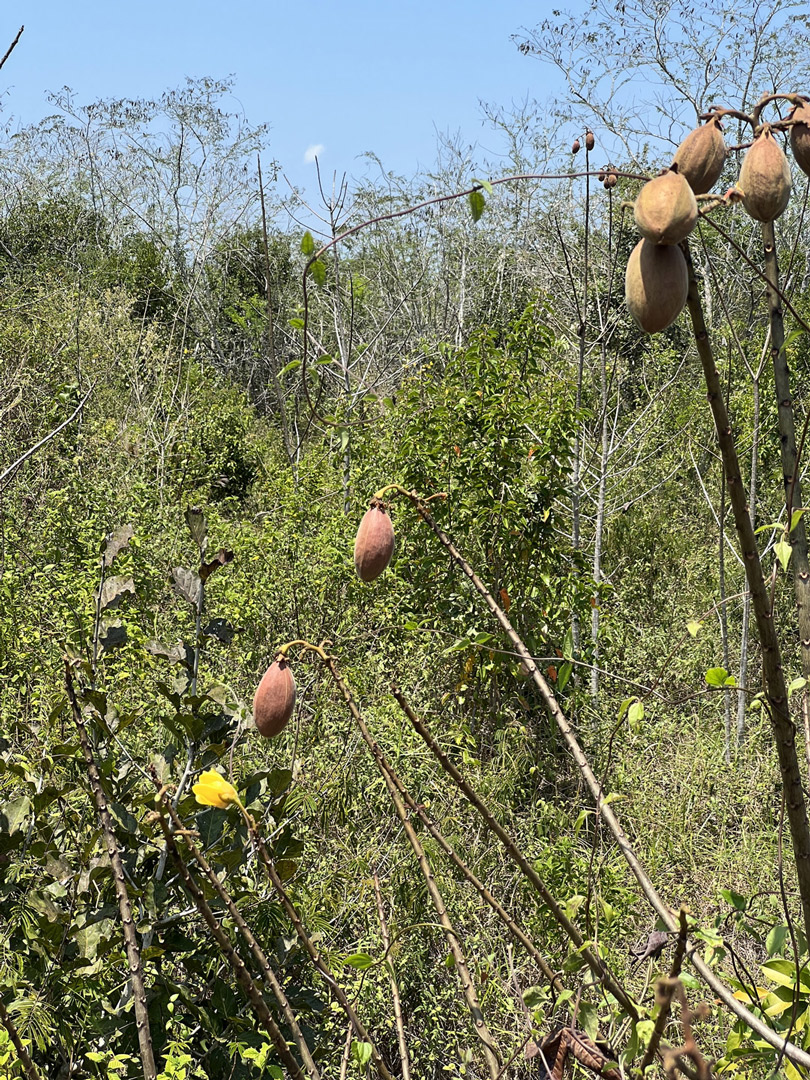Multi-use Tree not featured in books on the Classic Maya: Cochlosperum vitifolium, Tecomasuche
During our March-April expedition as part of the Reserva de la Biósfera Maya (RBM) biodiversity documentation project, we were exploring the existing savannas at the entrance of the Laguna del Tigre National Park (PNLT). We are interested in this type of ecosystems because they are seldom studied and because of the possibility of finding interesting plants. This time was no exception, during the walk to Savanna #25 of the 33 that we have identified, we found many Tecomasuche (Cochlosperum vitifolium) trees. What caught our attention were its fruits, since its seeds contain long, silky hairs, which give it an appearance similar to cotton. So the seed pods inside remind you kapok (silk cotton fluff around the seeds) of Ceiba aesculifolia and Ceiba pentandra. Later we discovered that Tecomasuche has multiple uses.
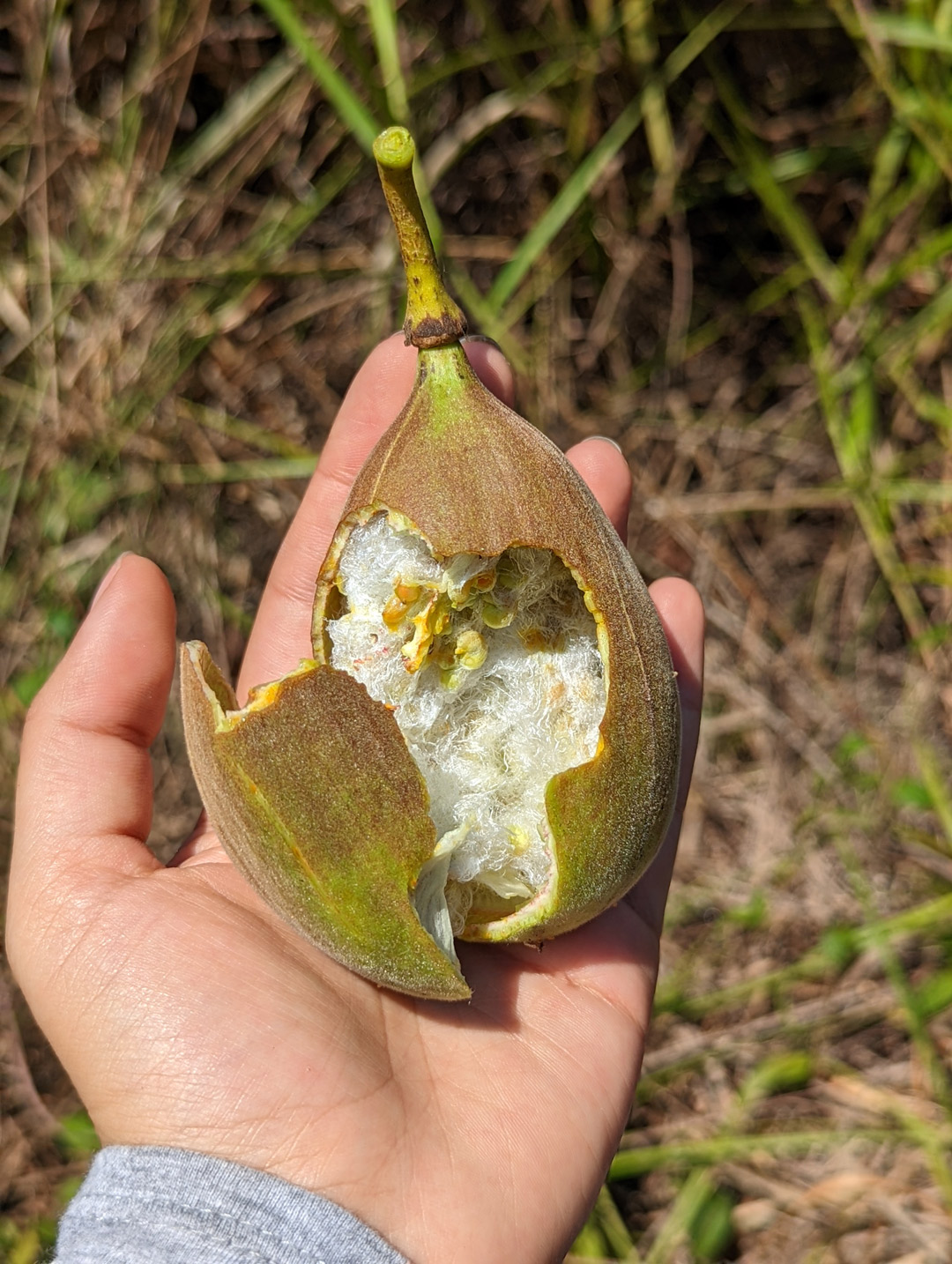 |
Tecomasuche seeds (Cochlospermum vitifolium). PNLT (2022). This pod is not yet fully ripe but you can see the “cotton” developing around the seeds. Photo by Vivian Hurtado |
Forest garden or Kitchen Garden? Why not Savanna Gardens?
Dozens of capable ethnobotanists have documented the plants that grow around the homes of Mayan people. These are called home gardens or kitchen gardens because they are more than just decorative plants: many of these herbs, shrubs, and trees produce edible parts for Mayan food. Kitchen gardens are documented for the Mayan people of Guatemala but more for Campeche, Yucatan, Belize and other parts of the Maya Lowlands. You don’t often find Tecomasuche, Cochlospermum vitifolium, in a kitchen garden but we definitely recommend it.
Forest gardens have been a helpful addition to the over-hyped milpa slash-and-burn maize-beans-and-squash trinity propagated by several Carnegie Instituion of Washington archaeologists and colleagues of that era (1930’s-1950’s). Lots of botanists, ethnobotanists and archaeologists have written about forest gardens (Puleston, utilizing suggestions by Cyrus Lundell, put ramon on the map of Classic Maya foods. Other scholars have continued to champion the forest garden theory.
Bajos have been championed by many helpful archaeologists, ethnobotanists and botanists as a place the Classic Maya almost certainly used for agriculture. Corozal areas (named corozera in remote areas of Peten) within a bajo are widely considered the most fertile part of a bajo. We are finding corozeras also on hillsides, usually parallel to an area that carries water downhill when it rains). We have documented two corozeras within Bajo La Justa (between Yaxha and Nakum). Naranjo-Sa’al team have guided us to a very moist corozera along the west edge of the ruins (the savanna portion; transition to cibal are at north end of Baja La Pita, is to the west). There are other corozeras within PNYNN that we look forward to documenting.
But so far I have not found a journal article or monograph or report on Classic Maya use of savannas of the PNYNN (Parque Nacional Yaxha, Nakum and Naranjo) or PNLT (Parque Nacional Laguna del Tigre) areas of the Reserva de la Biosfera Maya (RBM). Yet every month that we hike into a different previously undocumented savanna we find edible plants. During two field trips of year 2022 we found several savannas literally filled with Tecomasuche trees. These Cochlospermum vitifolium have so many practical uses in the Mayan world that surely they were encouraged to grow where they are happy (namely savannas and transition zones to the surrounding bajo forests).
Tecomasuche, Cochlospermum vitifolium like full sun, so I am accustomed to see them along Highway CA-9 as you enter the beginning of the bosque seco corredor. I had no idea that Tecomasuche, Cochlospermum vitifolium liked to grow in savannas until we hiked into remote areas of the southeast part of Parque Nacional Laguna del Tigre (the local people tell us that no professor or research project has studied any of this remote part of the park).
I do not remember seeing Tecomasuche, Cochlospermum vitifolium in savannas of Parque Nacional Yaxha, Nakum and Naranjo, but unless you are in a savanna in February, March or April, you would not notice the eye-catching yellow flowers. But we should return to the PNYNN savannas and double-check, since Cochlospermum vitifolium are listed for savannas of Belize (Goodwin et al. 2013: 36).
Taxonomy for Cochlospermum vitifolium
|
Dominian |
Eukaryota |
|
Kingdom |
Plantae |
|
Phylum |
Magnoliophyta |
|
Class |
Magnoliopsida (=Dicotyledoneae) |
|
Order |
Malvales |
| Family | Bixaceae |
| Genus | Cochlospermum |
| Species | Cochlospermum vitifolium |
Botanical Description of Cochlospermum vitifolium
Cochlospermum vitifolium is a tree that can reach up to 17m in height and 70cm in diameter at breast height. Its leaves are alternate, 10 to 30 cm wide, heart-shaped at the base, deep and palmately 5-lobed, lobes acuminate, crenate-serrate, glabrous above, puberulent below. The trunk is straight with smooth bark with ascending branches, quite thick and ungainly in appearance. The inflorescences are presented in clusters or panicles, which measure about 15 cm long and 45 cm wide; growing from the upper armpits. Its flowers have 4 or 5 petals and 4 or 5 sepals, yellow with reddish lines and spots and deep incisions; They have a diameter of 7.5 to 10 cm. They look a lot like simple roses (CONABIO, n.d.).
Tecomasuche is widely distributed from Mexico to South America. It is said to thrive in dry climates, but its flowers are larger in humid areas. It develops in type soils: clayey, brown-dry and limestone (CONABIO, n.d.).
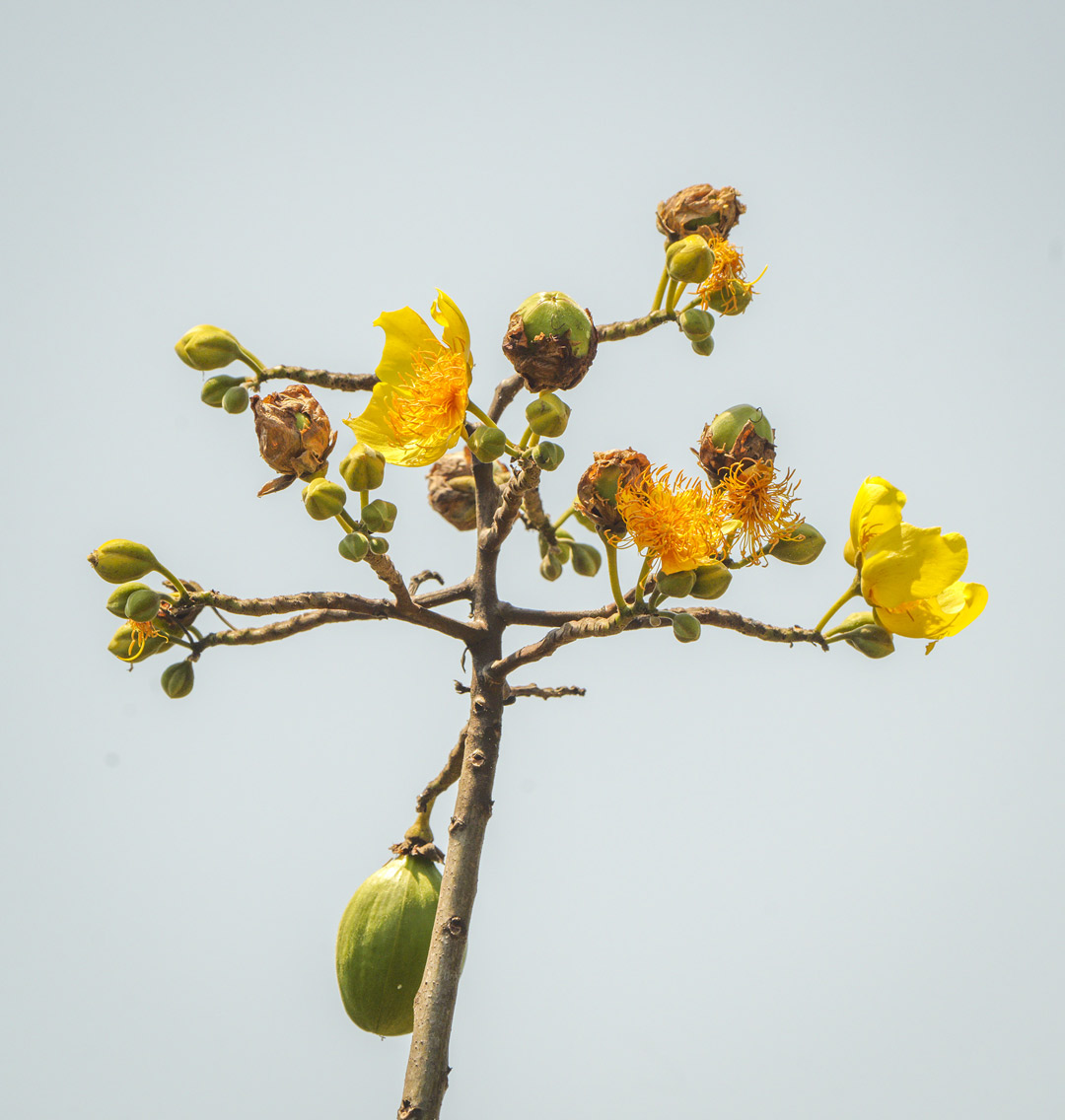 |
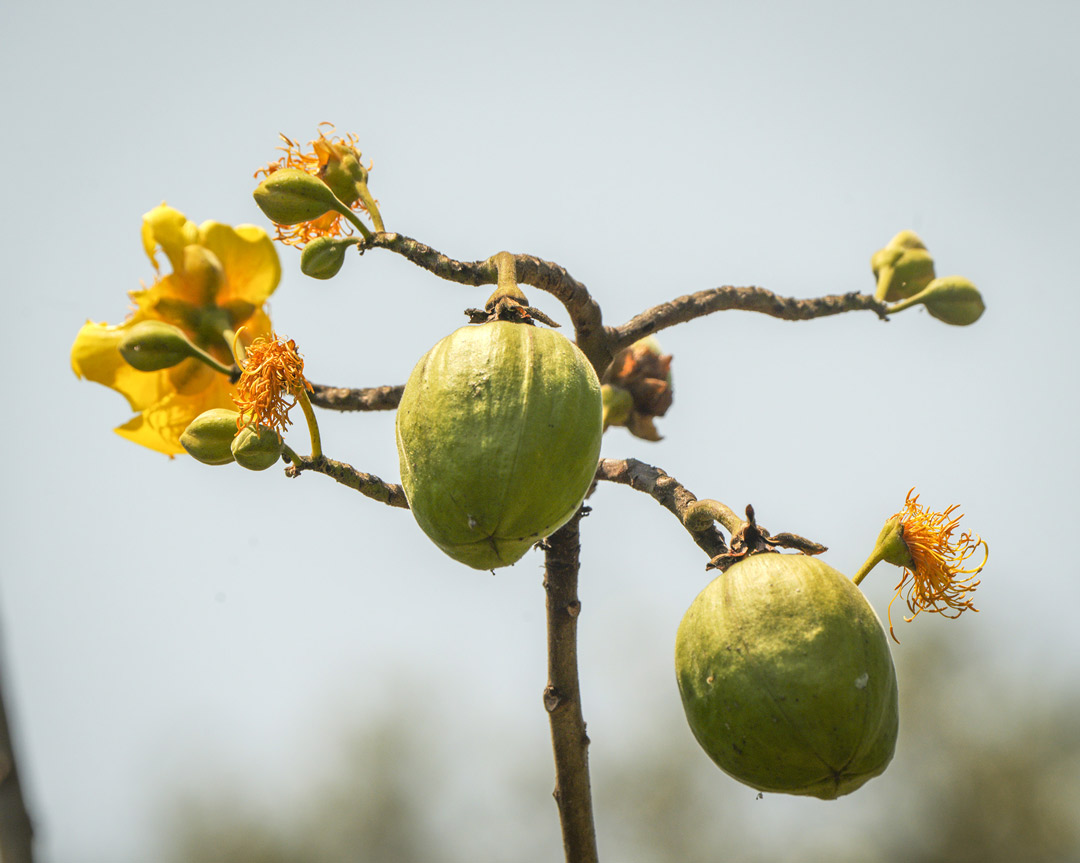 |
Flower and fruits of Tecomasuche (Cochlospermum vitifolium). In tasistal savannas of the southeast part of Parque Nacional Laguna del Tigre, PNLT (Feb, 2022) Photographs by Edwin Solares |
Uses of Tecomasuche, Cochlospermum vitifolium
The most common and wide use of parts of this tree species is medicinal. There are records of the varieties of medicinal uses that are given in different states of Mexico. For example, in the state of Oaxaca the cortex it is used to treat hepatitis, jaundice or tyricia. In Michoacán they also use it for the same purposes, however, the most common use is to treat diabetes; letting water rest in a piece of its trunk and drinking the water the next day when it is dyed. The fresh bark is also used to heal bumps or snake bites, or if the bark is cooked, the water can be used for douching. The crushed flowers can be used for chest conditions and the root is used to treat abscesses, inflammation of the intestines or to facilitate menstruation. (Cedano & Villaseñor, 2004; CONABIO, n.d.).
|
Use |
Part used |
| Dye | The wood produces a yellow-orange dye that is used to dye cotton clothing. |
| Construction and tools | Wood |
| Fiber | The silky white hair surrounds the seeds is used to embroider rugs and fill pillows and mattresses. The bark fiber is used to make ropes. |
| Forage | Deciduous leaves and flowers |
| Medicinal | Leaves, flowers, root and cortex |
| Melliferous | Flowers |
| Ornamental | Flowers |
Cochlospermum vitifolium in Mexico
Cochlospermum vitifolium (Willd.) Spreng. BCS, CAM, CHIS, CHIH, COL, DGO, GRO, HGO, JAL, MEX, MICH, MOR, NAY, OAX, PUE, QROO, SLP, SIN, SON, TAB, TAMS, VER, YUC, ZAC. (Villaseñor 2016: 670).
The Mayan areas of Mexico are Campeche, Chiapas, Quintana Roo, Tabasco and Yucatan, so this tree was available “almost everywhere” to the Classic Maya over a thousand years ago.
Cochlospermum vitifolium in Belize
Cochlospermum vitifolium (Willd.) Spreng. —Loc Use: MED. — Reg Use: MED, FOOD, FIBR, ORN, DYE, SPC. — Nv: amapa, chum, comasuche, cotton flower, pahote, wild cotton. — Habit: Shrub or tree. (Balick, Nee and Atha 2000: 72).
This tree is used by Mayan people (and their neighbors in Mesoamerica) for medicine, food, fiber, dye colorant, and spice or flavoring or preservatives (need to learn which for Cochlospermum vitifolium). Balick, Nee and Atha provide information for plants of Belize that is missing for plants of Peten, of Alta Verapaz, etc.
Cochlospermum vitifolium in Copan Ruinas, Honduras
Back in 2012 we found and photographed lots of Tecumasuche trees in the Copan Ruinas area of Honduras. This FLAAR Report is a photo essay, to show the yellow petals with yellow-orange inside parts. |
Cited References
- 2000
- Checklist of the Vascular Plants of Belize: with common names and uses. New York Botanical Garden. 246 pages.
Plant family index on-line: www.nybg.org/bsci/belize/families.html.
Book format not available on-line.
- 2004
- Usos y nombres comunes de las especies de Cochlospermaceae en México. Etnobiología 4: 73-88.
Available online: https://dialnet.unirioja.es/servlet/articulo?codigo=5294408.
- n.d.
- Cochlospermum vitifolium.
Available online: www.conabio.gob.mx/conocimiento/info_especies/arboles/doctos/25-cochl1m.pdf.
- 2013
- A checklist of the vascular plants of the lowland savannas of Belize, Central America. Phytotaxa 101 (1): 1–119.
Easy download www.eeo.ed.ac.uk/sea-belize/outputs/Papers/goodwin.pdf.
- 2016
- Checklist of the native vascular plants of Mexico. Revista Mexicana de Biodiversidad, Vol. 87, No. 3, pages 559-902.
Available online: www.redalyc.org/pdf/425/42547314001.pdf.
Suggested additional reading to learn more on Cochlospermum vitifolium
- 1952
- Flavonoids, Sterols and Lignans from Cochlospermum vitifolium and Their Relationship wit Its Liver Activity. Molecules, Vol. 23. 8 pages.
Available online: www.mdpi.com/1420-3049/23/8/1952.
- 2005
- Constituientes químicos voláteis e não-voláteis de Cochlospermum vitifolium (Willdenow) Sprengel. Química Nova, Vol. 28, No. 1. Pages 57-60.
Available online: www.scielo.br/j/qn/a/prgkDztQCXchnFYYCTLj9nt/?lang=pt.
- 2016
- Estudio fenológico de Cochlospermun vitifolium Willd y Eriotheca ruizii (K. Schum). Realizado en la Reserva Ecológica Arenillas. Ingeniería thesis. Universidad Técnica particular de Loja. 44 pages.
Available online: https://dspace.utpl.edu.ec/bitstream/123456789/17794/1/Cahuana_Palma_Wendy_Karina.pdf.
- 2005
- Uso local y potencial de las especies arbóreas en camarón de Tejeda, Veracruz. Revista Chapingo Serie Ciencias Forestales y del Ambiente, Vol. 11, No. 1. 7 pages.
Available online: www.redalyc.org/pdf/629/62911107.pdf.
- 2010
- Phenology, Lignotubers, and Water Relations of Cochlospermum vitifolium, a Pioneer Tropical Dry Forest Tree in Costa Rica. Biotropica, Vol. 42, No. 1. Pages 104-111.
Available online: LINK.
- 2010
- Phenology, Lignotubers, and Water Relations of Cochlospermum vitifolium, a Pioneer Tropical Dry Forest Tree in Costa Rica. Biotropica, Vol. 42, No. 1. Pages 104-111.
Available online: https://onlinelibrary.wiley.com/doi/abs/10.1111/j.1744-7429.2009.00539.x.
- 2012
- Tecomasuche, Cochlospermum vitifolium. FLAAR Reports. 7 pages.
Available online: https://www.maya-ethnobotany.org/FLAAR-Reports-Mayan-ethnobotany-Iconography-epigraphy-publications-books-articles-PowerPoint-presentations-course/12_Cochlospermum-vitifolium-tecomasuche-maya-ethnobotany-report.pdf.
- 2009
- Acute and sub-chronic effects of Cochlospermum vitifolium in blood glucose levels in normoglycemic and Stz-Nicotinamide-Induced diabetic rats. Rev. Latinoamer. Quim., Vol. 37, No. 2. Pages 122-132.
- 2012
- Caracterización fenológica de Cecropia peltata, Mimosa tenuiflora y Cochlospermum vitifolium en diferentes elevaciones en la subcuenca del río Yeguare, Honduras. 28 pages.
Available online: https://bdigital.zamorano.edu/bitstream/11036/890/1/IAD-2012-T018.pdf.
- 1982
- Stratum, Tree, and Flower Selection by Tropical Bees: Implications for the Reproductive Biology of Outcrossing Cochlospermum vitifolium in Panama. Ecology, Vol, 63, No. 3. Pages 712-720.
Available online: https://esajournals.onlinelibrary.wiley.com/doi/abs/10.2307/1936792.
- 2007
- Hypoglycemic, vasorelaxant and hepatoprotective effects of Cochlospermum vitifolium (Willd.) Sprengel: A potential agent for the treatment of metabolic syndrome. Journal of Ethnopharmacology, Vol. 109. Pages 400-405.
Available online: www.sciencedirect.com/science/article/abs/pii/S0378874106004053.
- 2010
- Cochlospermum vitifolium induces vasorelaxant and antihypertensive effects mainly by activation of NO/cGMP signaling pathway. Journal of Ethnopharmacology, Vol. 130, No. 3. Pages 477-484.
Available online: www.sciencedirect.com/science/article/abs/pii/S0378874110003570.
- 2021
- Flora y Vegetación de la Reserva de la Biosfera Zicuirán-Infiernillo, Michoacán, México. Botanical Sciences, Vol. 99, No. 3. Pages 661-707.
Preview online:
www.scielo.org.mx/pdf/bs/v99n3/2007-4476-bs-99-03-661.pdf
First posted April 11, 2022 by Vivian Hurtado and Nicholas Hellmuth Bibliography prepared by María José Toralla

